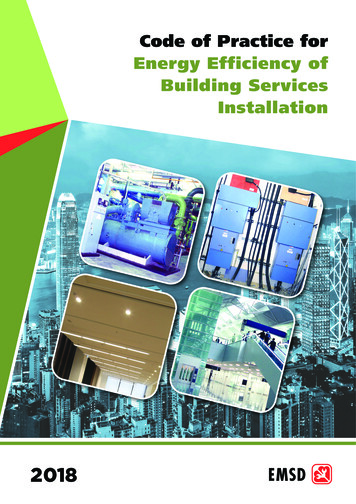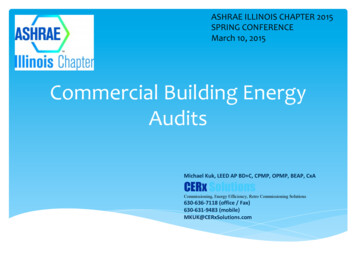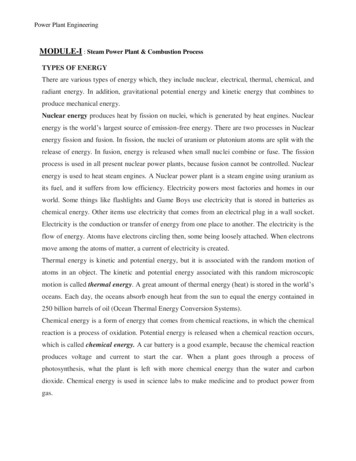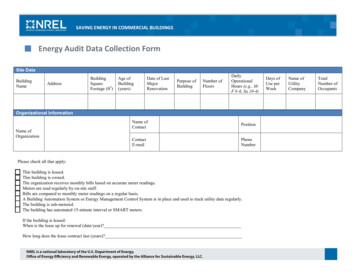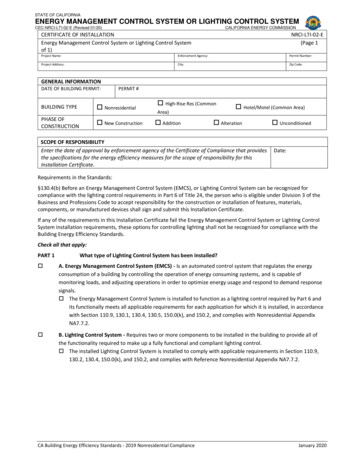
Transcription
STATE OF CALIFORNIAENERGY MANAGEMENT CONTROL SYSTEM OR LIGHTING CONTROL SYSTEMCEC-NRCI-LTI-02-E (Revised 01/20)CALIFORNIA ENERGY COMMISSIONCERTIFICATE OF INSTALLATIONEnergy Management Control System or Lighting Control Systemof 1)NRCI-LTI-02-E(Page 1Project Name:Enforcement Agency:Permit Number:Project Address:City:Zip Code:GENERAL INFORMATIONDATE OF BUILDING PERMIT:PERMIT #BUILDING TYPE NonresidentialPHASE OFCONSTRUCTION New Construction High-Rise Res (CommonArea) Addition Hotel/Motel (Common Area) AlterationSCOPE OF RESPONSIBILITYEnter the date of approval by enforcement agency of the Certificate of Compliance that providesthe specifications for the energy efficiency measures for the scope of responsibility for thisInstallation Certificate. UnconditionedDate:Requirements in the Standards:§130.4(b) Before an Energy Management Control System (EMCS), or Lighting Control System can be recognized forcompliance with the lighting control requirements in Part 6 of Title 24, the person who is eligible under Division 3 of theBusiness and Professions Code to accept responsibility for the construction or installation of features, materials,components, or manufactured devices shall sign and submit this Installation Certificate.If any of the requirements in this Installation Certificate fail the Energy Management Control System or Lighting ControlSystem installation requirements, these options for controlling lighting shall not be recognized for compliance with theBuilding Energy Efficiency Standards.Check all that apply:PART 1What type of Lighting Control System has been installed? A. Energy Management Control System (EMCS) - Is an automated control system that regulates the energyconsumption of a building by controlling the operation of energy consuming systems, and is capable ofmonitoring loads, and adjusting operations in order to optimize energy usage and respond to demand responsesignals. The Energy Management Control System is installed to function as a lighting control required by Part 6 andits functionally meets all applicable requirements for each application for which it is installed, in accordancewith Section 110.9, 130.1, 130.4, 130.5, 150.0(k), and 150.2, and complies with Nonresidential AppendixNA7.7.2. B. Lighting Control System - Requires two or more components to be installed in the building to provide all ofthe functionality required to make up a fully functional and compliant lighting control. The installed Lighting Control System is installed to comply with applicable requirements in Section 110.9,130.2, 130.4, 150.0(k), and 150.2, and complies with Reference Nonresidential Appendix NA7.7.2.CA Building Energy Efficiency Standards - 2019 Nonresidential ComplianceJanuary 2020
STATE OF CALIFORNIAENERGY MANAGEMENT CONTROL SYSTEM OR LIGHTING CONTROL SYSTEMCEC-NRCI-LTI-02-E (Revised 01/20)CALIFORNIA ENERGY COMMISSIONCERTIFICATE OF INSTALLATIONEnergy Management Control System or Lighting Control Systemof 4)NRCI-LTI-02-E(Page 2Project Name:Enforcement Agency:Permit Number:Project Address:City:Zip Code:PART 2 Lighting Control Functional requirements: Check all that apply when verifying the installation of an EMCS orLighting Control System. A. All lighting controls and equipment have been installed in accordance with the manufacturer's instructions. B. All installed EMCS systems meet each respective lighting control for which it is installed for meetingrequirements in Section 110.9, 130.1, 130.4, 150.0(k), and 150.2. C. Components of all installed lighting control systems meet applicable requirements in Section 110.9, 130.2,130.4, 150.0(k), and 150.2. D. The EMCS or the lighting control system functions as time-switch lighting control checked below, and complieswith all of the following requirements: 1. The EMCS or the lighting control system functions as a time-switch control meets the requirementsbelow:a. has program backup capabilities that prevent the loss of the device’s schedule for at least 7 days,and the device’s date and time for at least 72 hours if power is interrupted.b. Automatic time-switch controls installed in nonresidential buildings meet the followingrequirements:i.Is capable of providing manual override to each connected load and shall resume normallyscheduled operation after manual override is initiated within 2 hours for each connectedload; andii.Incorporates an automatic holiday shutoff feature that turns off all connected loads for atleast 24 hours and then resumes normally scheduled operation. 2. The EMCS or the lighting control system functions as an astronomical time-switch control meets therequirements below:a. Meets the requirements of an automatic time-switch control;b. Has sunrise and sunset prediction accuracy within plus-or-minus 15 minutes and timekeepingaccuracy within 5 minutes per year;c. Is capable of displaying date, current time, sunrise time, sunset time, and switching times foreach step during programming;d. Has an automatic daylight savings time adjustment; ande. Has the ability to independently offset the on and off for each channel by at least 99 minutesbefore and after sunrise or sunset. 3. Multi-Level Astronomical Time-Switch Controls, in addition to meeting all of the requirements forAstronomical Time-Switch Controls, includes at least 2 separately programmable steps per zone.E. The EMCS or the lighting control system functions as an automatic daylighting control meets the requirementsbelow:1. Automatically return to its most recent time delay settings within 60 minutes of the last receivedinput when put in calibration mode;2. Has a set point control that easily distinguishes settings to within 10% of full scale adjustment;3. Provide a linear response within 5% accuracy over the range of illuminance measured by the lightsensor;4. Be capable of being calibrated in a manner that the person initiating the calibration is remotefrom the sensor during calibration to avoid influencing calibration accuracy; andCA Building Energy Efficiency Standards - 2019 Nonresidential ComplianceJanuary 2020
STATE OF CALIFORNIAENERGY MANAGEMENT CONTROL SYSTEM OR LIGHTING CONTROL SYSTEMCEC-NRCI-LTI-02-E (Revised 01/20)CALIFORNIA ENERGY COMMISSIONCERTIFICATE OF INSTALLATIONEnergy Management Control System or Lighting Control Systemof 4)NRCI-LTI-02-E(Page 3Project Name:Enforcement Agency:Permit Number:Project Address:City:Zip Code: F. The EMCS or Lighting Control System functions as a dimming control and meet all of the requirements below:1. Is capable of reducing power consumption by a minimum of 65% when the dimming is at its lowestlevel;2. provides an off setting which produces a zero lumen output; and3. Reduce flicker operation through the dimming range so that the light output has an amplitudemodulation of less than 30% for frequencies less than 200 Hz without causing premature lamp failure.4. (For system designed for use in three way circuits:) be capable of turning lights off, and to the level setby the dimming controls if the lights are off. G. The EMCS or the lighting control system functions as an occupant sensing control and meets all of thefollowing requirements:1. Is capable of automatically turning the controlled lights in the area either off or down no more than 20minutes after the area has been vacated.2. (For system with manually-on control features:) have a grace period of no less than 15 seconds and nomore than 30 seconds to turn on lighting automatically after the sensor has timed out; and3. Provides a visible status signal that indicates that the control is operating properly, or that it has failedor malfunctioned. The visible status signal may have an override switch that turns off the signal.PART 3 Requirements for which the control is being installed to complied with:Identify all requirements in the Standards for which the EMCS or Lighting Control System is installed to function as andcomplies with:Check all that are in compliance with the Standards, Section 130.1: A. Section 130.1(a) Area Controls B. Section 130.1(b) Multi-Level Lighting Controls C. Section 130.1 (c) Shut-OFF Controls D. Section 130.1 (d) Automatic Daylighting Controls E. Section 130.1 (e) Demand Responsive Controls F. Section 130.5 (d) Circuit Controls for 120-Volt ReceptaclesCheck all that are applicable and in compliance with the Standards: A. Residential garages with 8 vehicles or more per site: All lighting controls must comply with nonresidential indoorlighting control requirements in Section 130.1. B. Single-Family Building Indoor Lighting. All indoor lighting controls must comply with Section 150.0(k)2. Garages with less than 8 vehicles per site: The lighting control must comply with Residential indoor lightingcontrol requirements in Section 150.0(k)2I. C. Low-Rise Residential Building Indoor Lighting. All indoor lighting controls of the dwelling units must comply with Section 150.0(k)2. Garages with less than 8 vehicles per site: The lighting control must comply with one of the following: Residential indoor lighting control requirements in Section 150.0(k)2I; Nonresidential indoor lighting control requirements in Section 130.1. Interior Common Area Lighting:CA Building Energy Efficiency Standards - 2019 Nonresidential ComplianceJanuary 2020
STATE OF CALIFORNIAENERGY MANAGEMENT CONTROL SYSTEM OR LIGHTING CONTROL SYSTEMCEC-NRCI-LTI-02-E (Revised 01/20)CALIFORNIA ENERGY COMMISSIONCERTIFICATE OF INSTALLATIONEnergy Management Control System or Lighting Control Systemof 4)NRCI-LTI-02-E(Page 4Project Name:Enforcement Agency:Permit Number:Project Address:City:Zip Code: For common areas equals 20 percent or less of the total building floor area, the installed lightingmust be controlled by occupant sensors. For common areas is greater than 20 percent of the total building floor area, the installed lightingcontrol must comply with the applicable nonresidential lighting control requirements. Corridor andstairwell lighting must be controlled by occupant sensors. D. High-Rise Residential Building Indoor Lighting. All indoor lighting controls of the dwelling units must comply with Section 150.0(k)2. Garages with less than 8 vehicles per site: The lighting control must comply with nonresidential indoorlighting control requirements in Section 130.1.CA Building Energy Efficiency Standards - 2019 Nonresidential ComplianceJanuary 2020
STATE OF CALIFORNIAENERGY MANAGEMENT CONTROL SYSTEM OR LIGHTING CONTROL SYSTEMCEC-NRCI-LTI-02-E (Revised 01/20)CALIFORNIA ENERGY COMMISSIONCERTIFICATE OF INSTALLATIONEnergy Management Control System or Lighting Control Systemof 4)NRCI-LTI-02-E(Page 5Project Name:Enforcement Agency:Permit Number:Project Address:City:Zip Code:DOCUMENTATION AUTHOR'S DECLARATION STATEMENT1. I certify that this Certificate of Installation documentation is accurate and complete.Documentation Author Name:Documentation Author Signature:Documentation Author Company Name:Date Signed:Address:CEA Certification Identification (If applicable):City/State/Zip:Phone:RESPONSIBLE PERSON'S DECLARATION STATEMENTI certify the following under penalty of perjury, under the laws of the State of California:1. The information provided on this Certificate of Installation is true and correct.2. I am eligible under Division 3 of the Business and Professions Code in the applicable classification to accept responsibility forthe system design, construction, or installation of features, materials, components, or manufactured devices for the scope ofwork identified on this Certificate of Installation and attest to the declarations in this statement (responsiblebuilder/installer), otherwise I am an authorized representative of the responsible builder/installer.3. The constructed or installed features, materials, components or manufactured devices (the installation) identified on thisCertificate of Installation conforms to all applicable codes and regulations, and the installation conforms to the requirementsgiven on the plans and specifications approved by the enforcement agency.4. I reviewed a copy of the Certificate of Compliance approved by the enforcement agency that identifies the specificrequirements for the scope of construction or installation identified on this Certificate of Installation, and I have ensured thatthe requirements that apply to the construction or installation have been met.5. I will ensure that a completed signed copy of this Certificate of Installation shall be posted, or made available with the buildingpermit(s) issued for the building, and made available to the enforcement agency for all applicable inspections. I understandthat a completed signed copy of this Certificate of Installation is required to be included with the documentation the builderprovides to the building owner at occupancy.Responsible Builder/Installer Name:Responsible Builder/Installer Signature:Company Name: (Installing Subcontractor or General Contractor orBuilder/Owner)Position With Company (Title):Address:CSLB License:City/State/Zip:PhoneCA Building Energy Efficiency Standards - 2019 Nonresidential ComplianceDate Signed:January 2020
CEC-NRCI-LTI-02-E (Revised 01/20) CALIFORNIA ENERGY COMMISSION CERTIFICATE OF INSTALLATION NRCI-LTI-02-E Energy Management Control System or Lighting Control System (Page 5 of 4) Project Name: Enforcement Agency: Permit Number: Project Address: City: Zip Code: CA Building Energy Effici




